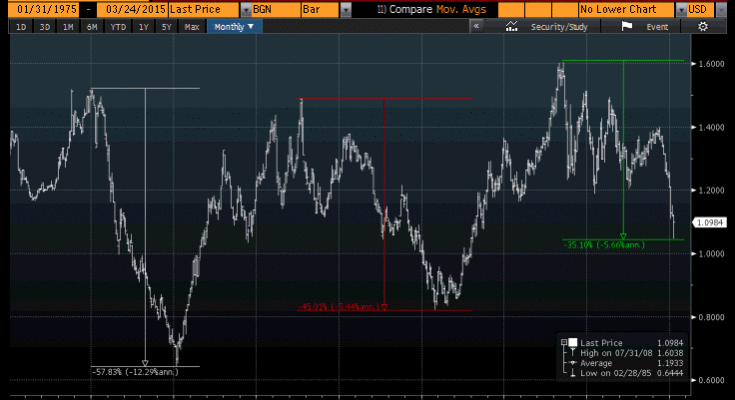This Great Graphic was composed on Bloomberg. It is a monthly bar chart of the real and theoretical euro prior to the launch of monetary union. The euro is in its third major bear market since the end of Bretton Woods. Â

The first bear market is associated with the policy overshoot with Reagan’s stimulative monetary policy and Volcker’s tight monetary policy. The euro’s equivalent lost about 58% of its value (white line).
The second bear market is associated with the Clinton presidency and the ERM crisis in the early 1990s. The euro and its equivalent lost 45% of its value. before the bear market ended (red line).Â
The current bear market has seen the euro fall 35% from its 2008 peak near $1.60 (green line). We expect it to fall 50% from peak to trough before the bear market is over. This would bring it toward the lows may in 2000.Â
The housing market bubble was predicated on the idea that house prices could only rise. We were told by many that we were at peak oil. Oil prices would stay elevated as supplies were consumed. Producers borrowed, and banks and investors lent on this basis. The same logic is unfolding with the dollar. Â
For years, many argued that the dollar was in an extricable decline. The US model of capitalism broke with Bear Stearns and Lehman’s collapse. It was the euro, then SDRS, bitcoins and the Chinese yuan that was going to supplant the dollar. This thinking, coupled with the low rates in the US (fueled at least in part by QE) encouraged corporations and countries to borrow dollars. Â
How much dollar borrowing was there? The BIS estimates that between 2009 and 2014, the dollar denominated debts of developing countries (bank loans and bonds) more than doubled to $4.5 trillion. Chinese corporations, many at least partially state owned, have drunk deeply at the dollar well. Almost a quarter of their debt is denominated in dollar. In addition to this European corporates and sovereigns also issued dollar denominated bonds. Â

